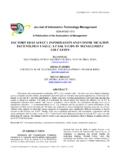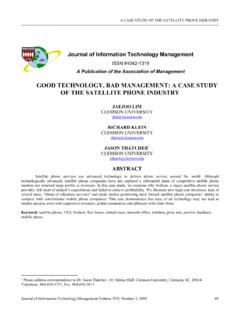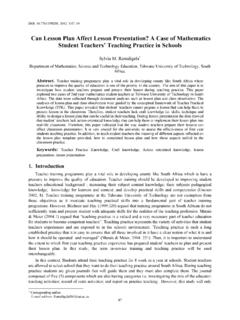Transcription of FACTORS THAT AFFECT INFORMATION AND …
1 FACTORS that AFFECT ICT USAGE. Journal of INFORMATION Technology Management ISSN #1042-1319. A Publication of the Association of Management FACTORS that AFFECT INFORMATION AND COMMUNICATION. TECHNOLOGY USAGE: A CASE STUDY IN MANAGEMENT. EDUCATION. ELA GOYAL. SIES COLLEGE OF MANAGEMENT STUDIES, NAVI MUMBAI, INDIA. SEEMA PUROHIT. NM INSTITUTE OF TECHNOLOGY AND DEVELOPMENT, MUMBAI, INDIA. MANJU BHAGAT. BIT, MESRA, RANCHI, INDIA. ABSTRACT. INFORMATION and communication technology (ICT) which includes radio, television and newer digital technology such as computers and the internet, are potentially powerful tools for extending educational opportunities, formal and non- formal, to one and all. It provides opportunities to deploy innovative teaching methodologies and interesting material that creates an interest in students.
2 This study is to determine the critical FACTORS that impact the effective use of ICT in management education from students' and teachers' perspective, and to identify the expectations and gaps in its use in management education. A questionnaire-based survey was conducted and the perception of various stakeholders of the importance of these FACTORS was analyzed. The study was conducted at various management institutes across the city of Navi Mumbai. Data analysis revealed that various categories of respondents gave significantly different importance to FACTORS relevant for the effective use of ICT. Notably, there was a significant gap between the respondents' expectations and the actual satisfaction with the current usage of ICT. Certain FACTORS which appeared to be barriers towards ICT usage were also found from the analysis.
3 The findings could be useful to any management institution which is thinking of making effective use of ICT in its curriculum. Keywords: ICT, INFORMATION technology, communication technology, critical FACTORS , management education elements has been the ability to engage learners in an INTRODUCTION interactive format [3,8]. Schrand [18] suggests the use of technology in education has several benefits for INFORMATION and Communication Technology motivating students. Schrand further states that continues to be commonly used for global communication technology can facilitate more active student learning in and productivity. Since the earliest use of the World Wide the classroom, and appeal to multiple intelligences, and Web for teaching and learning, one of its most powerful Journal of INFORMATION Technology Management, Volume XXI, Number 4, 2010 38.
4 FACTORS that AFFECT ICT USAGE. different learning styles. Jonassen, Howland, Marra and investments in ICT are uncertain and may not always Crismond [9] state that technology can be only effective align with the intentions of school administrators. Another in the learning process when it meets a learning study conducted by Michael Laff [11] in Princeton in requirement. Access to technology related multimedia has 2007 compared the learning preferences of IT. previously been shown [1] to improve cognitive professionals with professionals from other sectors and engagement and cognitive absorption in users. Great found that while training professionals in other fields are expectations have emerged for technological advances to wrestling with the best way to offer active learning in the meet society's demands in new way.
5 Many universities digital age, intensive classroom curriculums are still and private corporations are investing significant capital widely available for IT professionals. Online training, in e-learning systems [13]. A variety of these higher blended learning and other upstart methods may be the education institutions are driven by an enormous increase future as many organizations move away from traditional in the global demand for higher education, which provides classroom instruction, but in the IT field, instructor- led new opportunities to contribute to the educational process. training remains the preferred method for many However, as many projects such as the UK e- applications. The study says the ideal way to offer University, NYU Online, Scottish Knowledge, blended learning to IT workers would be four weeks of Universities 21 and Global University Alliance (GUA), classroom instruction with participant interaction and then which all developed around e-learning applications, have four weeks participants working on their own to build failed to realize their aims and goals, leading many to skills and learn techniques.
6 Study conducted by Nor question the quality and capabilities of this form of Shariza Abdul Karim[15] (Malaysia) and Robert education. Full understanding of the FACTORS contributing Heckman(USA) in 2005 said that The learning industry to effectiveness of e-learning systems will help E- is undergoing a transformation process through the use of Universities and institutions channel funding to effective innovative products and tools from the ICT revolution. FACTORS and redesign or eliminate non-effective FACTORS However it is important that the tools are evaluated for (Levy, 2006). appropriateness, effectiveness and usability from the In this paper we are not restricting to only e- user's point of view. This understanding can assist learning, but widening the scope to include the all educators in choosing the best product and in managing INFORMATION technologies and communication the tools for optimum benefit.
7 They investigated group technologies that are or can be used in education. Critical communication media choice and the use of a web-based FACTORS can be viewed as those activities and constituents learning tool, as well as other types of communication that must be addressed in order to ensure its successful media such as email, telephone and face-to-face, for accomplishment and acceptance by the various communication and collaboration to complete given tasks. stakeholders. This is an empirical study to find out what The study conducted by Phil Banyard and Jean would make ICT usage in management education Underwood in 2007 [2] captured teachers' perceptions of effective from the students and teachers perspective. support for and attitudes towards use of ICT in their school and also the degree to which they were encouraged LITERATURE REVIEW and had responded to the personalisation of teaching and learning.
8 The result showed that while teachers were A broad range of FACTORS that can influence the positive about both the personalisation agenda and the use of technology in learning has been mentioned in the role of ICT in delivering that agenda, there were literature. Successful implementation of ICT change is not significant inter-subject differences with mathematics about equipment or software but influencing and teachers seeing the least value of the personalisation empowering teachers; it is not about acquiring computer policy and design and technology teachers being skills but supporting teachers in the ongoing engagement unconvinced by the value of ICT. Another study with students in their learnings [21]. A study was conducted in UK in 2004 by Gordan Graham [6] says that conducted by Neset Hikmet, Eileen Z.
9 Taylor and before using or discarding any technology, the following Christopher J. Davis [14] in 2008 in US. They concluded questions should be answered: What is the anticipated that before investing heavily in ICT, school administrators benefit of the innovation and will it be genuinely should appreciate that the nature of productivity' in additional benefit? Is the chance of it being implemented learning is elusive. Their study provided some well- successfully higher than the chance of its failure? What is reasoned empirical evidence that highlights that the the cost of its introduction in terms of disruption to the specific needs and expectations of students, teachers, existing systems that are tried, known and reliable? Are parents and administrators who adopt ICT for use in there recurrent patterns of behavior that would give some education should be studied as the outcomes of pointers to its likely reception?
10 Journal of INFORMATION Technology Management, Volume XXI, Number 4, 2010 39. FACTORS that AFFECT ICT USAGE. Based on the insights obtained from the study by discussed seven e-learning critical FACTORS namely, The Institute for Higher Education Policy in 2000, the key institutional support, course development, teaching and FACTORS for successful e-learning environments are - learning, course structure, student support, faculty Institutional Support, Course Development, support, and evaluation and assessment. Fresen [4] in an Teaching/Learning Process, Course Structure, Student inclusive study highlighted six critical success FACTORS in Support, Faculty Support, Evaluation and Assessment. his study: According to Papp's study [17] e-learning critical success Institutional FACTORS (Technology plan, FACTORS included intellectual property rights, suitability of Infrastructure, Student advice and consultation, the course for e-learning environment, building the e- Institutional evaluation of the program effectiveness), learning course, e-learning course content, e-learning Technology FACTORS (Reliability, 24X7 availability, course maintenance, e-learning platform, and measuring Technical support for lecturers and students, System the success of an e-learning course.)











